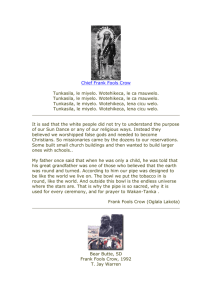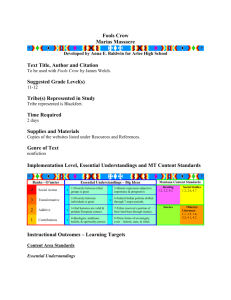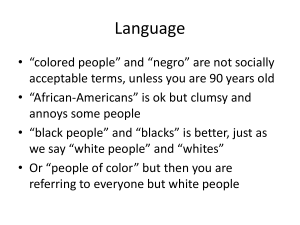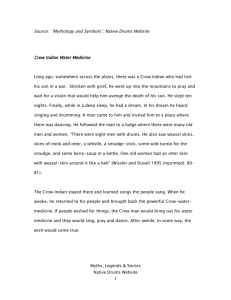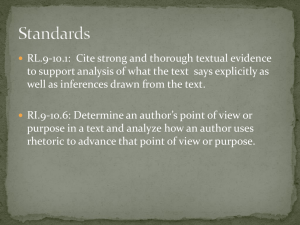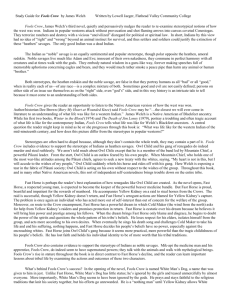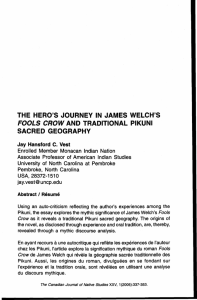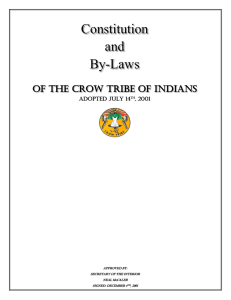"Shadow of a Nation" Text Study: Crow Culture & History
advertisement
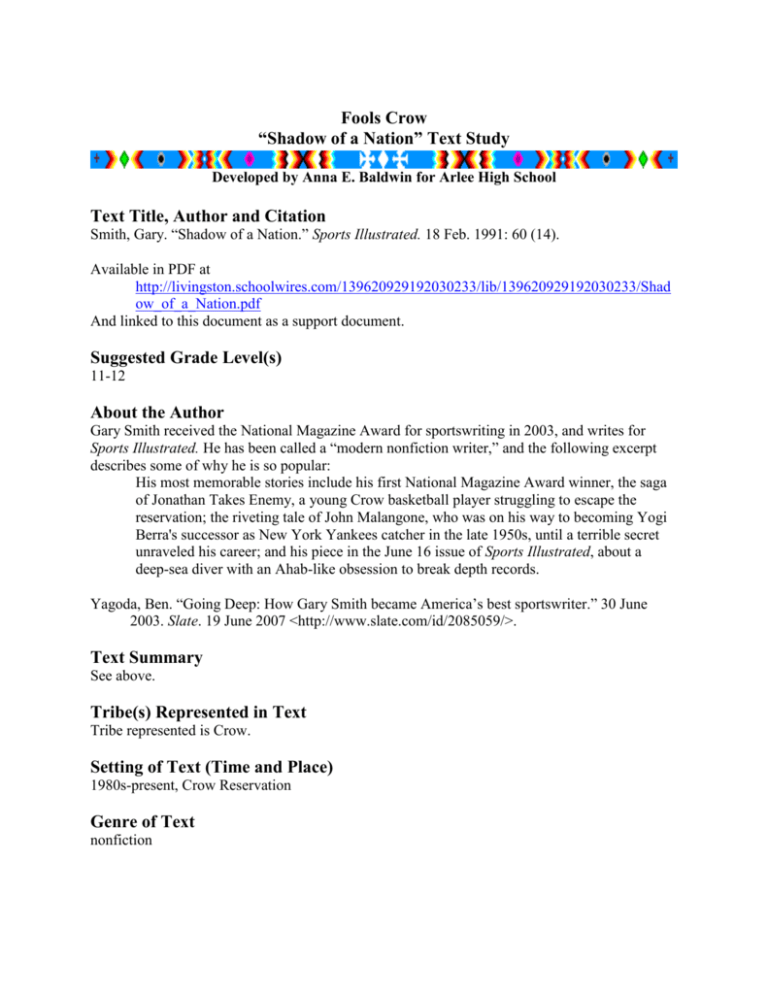
Fools Crow “Shadow of a Nation” Text Study Developed by Anna E. Baldwin for Arlee High School Text Title, Author and Citation Smith, Gary. “Shadow of a Nation.” Sports Illustrated. 18 Feb. 1991: 60 (14). Available in PDF at http://livingston.schoolwires.com/139620929192030233/lib/139620929192030233/Shad ow_of_a_Nation.pdf And linked to this document as a support document. Suggested Grade Level(s) 11-12 About the Author Gary Smith received the National Magazine Award for sportswriting in 2003, and writes for Sports Illustrated. He has been called a “modern nonfiction writer,” and the following excerpt describes some of why he is so popular: His most memorable stories include his first National Magazine Award winner, the saga of Jonathan Takes Enemy, a young Crow basketball player struggling to escape the reservation; the riveting tale of John Malangone, who was on his way to becoming Yogi Berra's successor as New York Yankees catcher in the late 1950s, until a terrible secret unraveled his career; and his piece in the June 16 issue of Sports Illustrated, about a deep-sea diver with an Ahab-like obsession to break depth records. Yagoda, Ben. “Going Deep: How Gary Smith became America’s best sportswriter.” 30 June 2003. Slate. 19 June 2007 <http://www.slate.com/id/2085059/>. Text Summary See above. Tribe(s) Represented in Text Tribe represented is Crow. Setting of Text (Time and Place) 1980s-present, Crow Reservation Genre of Text nonfiction Time Required 2 days Supplies and Materials Copies of “Shadow of a Nation” for each student. Map of Montana with reservations. Implementation Level, Essential Understandings and MT Content Standards Banks - O’meter Essential Understandings – Big Ideas 4 Social Action x 1-Diversity between tribal groups is great. 5-History represents subjective experience & perspective. 3 Transformative x 2-Diversity between individuals is great. 6-Federal Indian policies shifted through 7 major periods. 2 Additive 3-Oral histories are valid & predate European contact. 7-Tribes reserved a portion of their land-base through treaties. 1 Contributions 4-Ideologies, traditions, beliefs, & spirituality persist 8-Three forms of sovereignty exist – federal, state, & tribal. x Montana Content Standards Reading 1.1, 1.3, 2.3, 5.1 Social Studies 3.1, 6.2, 6.4, 6.5 Science Other(s) Literature 4.4, 5.4 Instructional Outcomes – Learning Targets Content Area Standards Essential Understandings Essential Understanding 1: There is great diversity among the 12 tribal Nations of Montana in their languages, cultures, histories and governments. Each Nation has a distinct and unique cultural heritage that contributes to modern Montana. Essential Understanding 2: There is great diversity among individual American Indians as identity is developed, defined and redefined by many entities, organizations and people. There is a continuum of Indian identity ranging from assimilated to traditional and is unique to each individual. There is no generic American Indian. Essential Understanding 3: The ideologies of Native traditional beliefs and spirituality persist into modern day life as tribal cultures, traditions and languages are still practiced by many American Indian people and are incorporated into how tribes govern and manage their affairs. Social Studies Students will 3.1 interpret, use, and synthesize information from various representations of the Earth (e.g., maps, globes, satellite images, geographic information systems, three-dimensional models). 6.2 analyze human experience and cultural expression (e.g., language, literature, arts, traditions, beliefs, spirituality, values, behavior) and create a product which illustrates an integrated view of a specific culture. 6.4 evaluate how the unique characteristics of American Indian tribes and other cultural groups have contributed to Montana’s history and contemporary life (e.g., legal and political relationships between and among tribal, state, and federal governments). 6.5 analyze the conflicts resulting from cultural assimilation and cultural preservation among various ethnic and racial groups in Montana, the United Sates and the world. Skill Sets Reading Students will 1.1 make predictions and describe inferences and connections within material and between new material and previous information/experiences. 1.3 provide oral, written, and/or artistic responses to ideas and feelings generated b the reading material, providing examples of the way these influence one’s life and role in society. 2.3 identify, analyze, and evaluate the use of literary devices (e.g., figurative language, exaggeration, irony, humor, dialogue, satire, symbolism). 5.1 compare and contrast information and broad themes within and among a variety of information sources. Literature Students will 4.4 analyze diverse literature to identify and compare common human experiences within and between cultures. 5.4 investigate and report ways in which authors, their works, and their styles have impacted or been influenced by social and cultural issues or events. Learning Experiences – Text-Based Inquiry Unit Essential Question: How can “Shadow of a Nation” and Fools Crow be compared? Placement of lesson: after finishing the novel Fools Crow. Before – Day One Find the Crow Reservation on the Montana map. Your students might do a little research on its size, population, life expectancy, and so on. Where are the towns and schools? What tribe(s) are represented? What language(s) are spoken? You can direct students (or find information ahead of time) to their official website: http://www.crowtribe.com/. This extra research could add a day or two to the entire lesson. Brainstorm as a class: Given what you know about what happened to the Blackfeet people, how might Crow be similar and different? During – Day One 1. As a class, read the quote from Plenty Coups that begins the article. Students should note that Plenty Coups was Chief of the Crows and died in 1930. Ask them to respond to the quote: what feelings does it evoke? Why do you think the author chose to begin the article with it? 2. Guide students to read the first two sentences of the first paragraph in the article: “Singing. Did you hear it? There was singing in the land once more that day.” How does that contrast with the end of the quote? Are happy or sad feelings elicited by that line about singing? Draw students’ attention to the author’s craft of bobbing back and forth between feelings through repetition and context. 3. Have students read the section individually up to “And then there was Takes Enemy…” Ask students to do a popcorn read of this section (see the “Before” section from the Poetry Immersion activity, first in the unit, for instructions on popcorn reading). 4. Tell students to read the rest of the article for homework, with the following purposes to be discussed the next day: 1. What are the important ideas or themes of this article? 2. How does the author use description to keep your attention? Make note of examples. 3. In what way(s) is the depiction of the Crows’ fate like and unlike that of the Blackfeet? During – Day Two 1. Entry ticket: Write one example you noted of the author’s use of description to keep your attention (#2 from yesterday’s list). 2. Do a whole-group brainstorm of “important ideas or themes.” Then assign pairs to find evidence in the text: where did they see certain ideas or themes arise? While students are doing this, you can look through their entry tickets to use some of the descriptions as discussion topics and questions. 3. Discuss as a whole group: What evidence did each group find for their themes? This can lead to a discussion of students’ responses to this article, bolstered by the entry tickets you scanned. 4. Use this as a link to the final purpose for reading and the Essential Question: How can “Shadow of a Nation” and Fools Crow be compared? Make a Venn diagram if necessary to track students’ ideas. After At the end of the note-taking/comparing session, you might ask students to do one of a number of final activities: Have them create an illustration for the article. Ask them to describe the importance of a sport or activity in their life, beyond simple hobby or pastime. Have a written conversation: that is, each student begins a letter to another student in the class (they won’t know who yet) and describes something from the article that may have been interesting, confusing, etc. Then you, the teacher, should collect these letters and redistribute them. Students will now have someone else’s letter in front of them to respond to. They will end up with two partners, the one they wrote to and the one they respond to. The key to written conversations is to keep the thread of the conversation going and to ask questions of the other person. Each round of the written conversation should take 510 minutes and you can do as many rounds as will keep the students’ attention. Usually about 4 is enough. Move on to an essay; ideas are listed below, in the Extension Activities. Extension Activities Write a compare/contrast paragraph or essay on these two texts. Write a theme essay on these texts (one or both). Some themes might include tradition, despair, loss of culture, importance of culture. Resources and References Crow Nation. 2007. 19 June 2007 < http://www.crowtribe.com/>. Smith, Gary. “Shadow of a Nation.” Sports Illustrated. 18 Feb. 1991: 60 (14). available in PDF at http://livingston.schoolwires.com/139620929192030233/lib/139620929192030233/Shad ow_of_a_Nation.pdf Yagoda, Ben. “Going Deep: How Gary Smith became America’s best sportswriter.” 30 June 2003. Slate. 19 June 2007 <http://www.slate.com/id/2085059/>.
